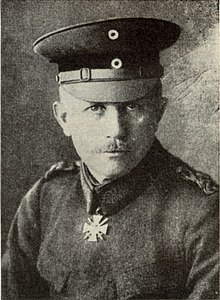Baltische Landeswehr
This article needs additional citations for verification. (February 2013) |
| Baltische Landeswehr | |
|---|---|
Harold Alexander | |
| Insignia | |
| Identification symbol | Shoulder strap piping in light blue and white, the Baltic colors. |
The Baltic Landwehr or Baltische Landeswehr ("Baltic Territorial Army") was the name of the unified
Command structure

The Landeswehr was subordinated to the German VI Reserve Corps which Generalmajor Rüdiger von der Goltz (military governor of Libau in Latvia from 1 February 1919) commanded from 2 February 1919[2] until 12 October 1919.
Commanders
- Major Emil von Scheibler (7 December 1918 - 6 February 1919)
- Major Alfred Fletcher (6 February 1919 - 3 July 1919)
- Lieutenant-Colonel Harold Alexander (British; July 1919)[1]
History

After the November 11, 1918,
Theaters and campaigns
In late February 1919 only the seaport of
Subsequent
After taking command of the Baltische Landeswehr in mid-July 1919, Lieutenant-Colonel
The Germans released from the Baltische Landeswehr were incorporated into the Deutsche Legion[4][circular reference] in September 1919. The legion served under the West Russian Volunteer Army commanded by Colonel Prince Pavel Bermondt-Avalov in his attempt to capture Riga, but suffered complete defeat by the end of November 1919.
The British insisted that General von der Goltz leave Latvia, and he turned his troops over to Bermondt-Avalov's
The purged Baltische Landeswehr units subsequently assisted in the liberation of Latgale from Bolsheviks together with Latvian and Polish armies in January 1920.
Prominent members

Prominent Baltic officers from the Landeswehr era include:
- Generalmajor Erich Alt (Luftwaffe) (leader of the 1. Baltischen Flieger-Abteilung (433))
- Generalmajor Rudolf Bader (in the Badisches Freiwilligen Abteilung Medem)
- Generalmajor Heinrich Baron von Behr
- Generalmajor z.V. Heinrich Burggraf und Graf zu Dohna-Schlobitten
- Generalmajor Karl Dormagen
- Generalmajor Dipl. Ing. Hans Henrici
- General der Artillerie Kurt Jahn
- Generalleutnant Heinrich Rauch (Luftwaffe) (aerial observer in Flieger-Abteilung 433)
- Oberst (Colonel) Wessel Freytag von Loringhoven
(the ranks are the highest ranks reached in the
Rank insignia
Members of the Baltische Landeswehr wore shoulder strap piping in light blue and white, the Baltic colors.
- Commissioned officers
| Rank group | Field/senior officers | Junior officers | |||
|---|---|---|---|---|---|
| Befehlshaber | Kommandeur Major |
Rittmeister
|
Kornett
|
Fähnrich | |
- Enlisted personnel
| Rank group | NCOs | Other ranks | |||
|---|---|---|---|---|---|
| Wachtmeister | Oberfeldmeister | Feldmeister | Gefreiter | Soldat | |
Order of battle (20 May 1919)
- 1. Deutsch-Balt. Kampfbataillon (Stoßtrupp Manteuffel; Baron Hans von Manteuffel)
- 2. Deutsch-Balt. Kampfbataillon (Hauptmann Malmede)
- 3. Deutsch-Balt. Kampfbataillon (Rittmeister Graf zu Eulenburg)
- MG-Scharfschützen-Abteilung (Hauptmann Freiherr von Khaynach)
- Russische Abteilung Fürst Lieven (Cavalry Captain Prince Anatolii Pavlovich Liven or, in German, Fürst Anatol Leonid Lieven)
- Lettische Kampf-Brigade (Colonel Jānis Balodis)
- Stamm-Kompanie Talssen
- Stamm-Kompanie Tuckum
- Balten-Kompanie des Gouvernement Libau
- Elements of the MG-Kompanie of III./Freiwilligen-Regiment Libau (Gouvernement Libau)
- Lettische Kavallerie-Abteilung
- Russische Kavallerie-Abteilung
- Kavallerie-Abteilung Engelhardt
- Kavallerie-Abteilung Drachenfels
- Kavallerie-Abteilung Pappenheim
- Kavallerie-Abteilung Halm
- 1. Deutsch-Balt. Batterie (Ehmke)
- 2. Deutsch-Balt. Batterie (Barth)
- 3. Deutsch-Balt. Batterie (Sievert)
- Deutsch-Balt. Haubitze-Batterie
- Russische Batterie (Röhl)
- Badisches Freiwilligen Abteilung Medem (attached Korpstruppe)
- Lettische Pionier-Kompanie
- Pionier-Abteilung Stromberg
- Balt. Fernsprech-Abteilung
- Lettische Fernsprech-Abteilung
- Balt. Funker-Abteilung
- Flieger-Abteilung 433 (attached Korpstruppe)
- Armee-Kraftwagen-Kolonne 021 (attached Korpstruppe)
- Staffel-Stab der Landeswehr (Major Wölki)
- Munitions- und Train-Kolonne I
- Munitions- und Train-Kolonne II
- Landeskolonne III
- Feldlazarett
- Sanitäts-Kompanie
- Sanitäts-Kraftwagen-Zug
- Wirtschafts-Kompanie 1
- Wirtschafts-Kompanie 2
- Bahnschutz-Detachement
- Pferdelazarett
- Sammeldepot Libau
See also
- Aftermath of World War I
- Bundeswehr
- Estonian War of Independence
- Freikorps in the Baltic
- German Army (German Empire)
- Latvian Riflemen
- Latvian War of Independence
- Ober Ost
- Reichswehr
- United Baltic Duchy
- Wehrmacht
References
- ^ a b c Colonel Jaan Maide (1933). Ülevaade Eesti Vabadussõjast (1918–1920) [Overview of the Estonian War of Independence (1918–1920)] (in Estonian). Archived from the original on 2010-08-22.
- ISBN 9783764817794. Retrieved 13 August 2022.
- ^ a b c Die Baltische Landeswehr im Befreiungskampf gegen den Bolschewismus: ein Gedenkbuch [The Baltic State Army in the liberation struggle against Bolshevism: a commemorative book] (in German). Riga: Ernst Plates. 1939.
- ^ de:Deutsche Legion (1919)
- ^ a b Boltowsky, Tomans; Thomas, Nigel (2019). Armies of the Baltic Independence Wars 1918-1920. Bloomsbury Publishing. p. 63.
Bibliography
- Goltz Rüdiger von der, Meine Sendung im Finland und im Baltikum, Leipzig 1920.
- Goltz Rüdiger von der, Minu missioon Soomes ja Baltikumis, Tartu, Loodus 1937; faksiimiletrükk Tallinn, Olion 2004. ISBN 9985-66-379-9.
- Bermond-Awaloff Pavel, Im Kampf gegen den Bolschevismus. Erinnerungen von..., Berlin 1925.
- BischoffJosef, Die letzte Front. Geschichte der Eiserne Division im Baltikum 1919, Berlin 1935.
- Darstellungen aus den Nachkriegskämpfen deutscher Truppen und Freikorps, Bd 2: Der Feldzug im Baltikum bis zur zweiten Einnahme von Riga. Januar bis Mai 1919, Berlin 1937; Bd 3: Die Kämpfe im Baltikum nach der zweiten Einnahme von Riga. Juni bis Dezember 1919, Berlin 1938.
- Die Baltische Landeswehr im Befreiungskampf gegen den Bolschewismus, Riga 1929.
- Eesti Vabadussõda 1918-1920, Tallinn, Mats, 1997. ISBN 9985-51-028-3.
- Kiewisz Leon, Sprawy łotewskie w bałtyckiej polityce Niemiec 1914-1919, Poznań 1970.
- Łossowski Piotr, Między wojną a pokojem. Niemieckie zamysły wojenne na wschodzie w obliczu traktatu wersalskiego. Marzec-kwiecień 1919, Warszawa 1976.
- Paluszyński Tomasz, Walka o niepodległość Łotwy 1914-1920, Warszawa 1999.
- Von den baltische Provinzen zu den baltischen Staaten. Beiträge zur Entstehungsgeschichte der Republiken Estland und Lettland, Bd I (1917-1918), Bd II (1919-1920), Marburg 1971, 1977.
